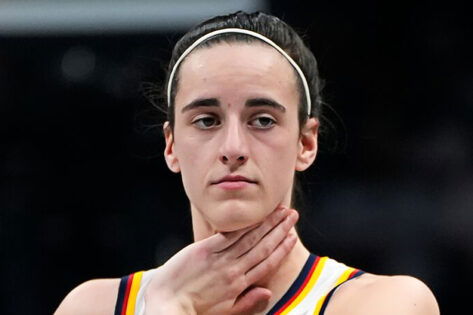While the Pacers were lighting up Gainbridge Fieldhouse with a 17-point lead to force a Game 7 in the NBA Finals, the Indiana Fever were just trying to stay afloat. Aaliyah Boston’s 17 points kept the Fever competitive against the Golden State Valkyries, but Caitlin Clark couldn’t buy a bucket. The Des Moines darling shot a cold 3-of-14 from the field and an icy 0-of-7 from deep. It was as if OKC’s historic three-point drought from game 6 had latched onto Clark. And when the final buzzer sounded on an 88-77 Fever loss, all eyes turned to Clark. But just when the pressure dialed up, her teammates stepped up.
“It’s not about CC specifically…we were soft…they made us pay by being stronger, tougher…we allowed it. They made us pay by just being stronger and being tougher. 50-50 balls, deflections, getting the passing lanes. That’s just a piece of just being aggressive and having an ability to, like, look at your best player, and be like, ‘Nah, they gonna be aggressive.’ And I think that we allowed it, kind of tucked our tail a little bit tonight, on the aggression side.,” said Kelsey Mitchell in the postgame presser.
Mitchell, who had 16 points on 6-of-11 shooting, wasn’t just backing up Clark with words—she was speaking from experience. When Clark was sidelined earlier this season from May 24 to June 11, Mitchell carried the scoring load. And she struggled. In four of those six games without Clark, she shot at or below 37%, including one of the worst slumps in the league with a 30.1% average (Fg% ) across that stretch. Fans and analysts questioned her volume and even pointed fingers at Dewanna Bonner for not taking enough shots. That stretch showed how quickly narratives can shift.
Which is why Mitchell’s postgame reflection was valuable insight that spoke from personal experience while defending Clark. In fact, her comments about “Kind of tucked our tail a little bit on the aggression side” make more sense with this insight. Why?
Well, the Fever took control early, going up 8-7 with 5:56 left in the first quarter. But they let the momentum slip away. Their last lead—a slim 61-60 edge with 8:11 left in the fourth—vanished as quickly as it came.
Yes, Clark missed all seven of her threes. Yes, she turned the ball over six times. But it wasn’t just her. The team had 17 turnovers. They allowed 10 points off those. And defensively, they gave up 12 fast break points while mustering just six of their own. They led in rebounds (35-32), field goal percentage (43.9%), and free throws (91.7%), but the miscues in transition and loose ball security told the real story.
Adding to the chaos was the absence of head coach Stephanie White, who was attending to personal matters. With Austin Kelly taking the reins, the Fever may have lacked the steadying presence they needed down the stretch.
In the end, Clark didn’t get rescued with stats—she got rescued with context, and in a league as volatile as the W, that kind of rescue is rarer than a 0-for-7 night from Caitlin Clark.
Caitlin Clark’s fame boosts the WNBA—but also brings a harsh spotlight.
And for the Iowa native—one of the top three most famous American athletes today—it was a much-needed rescue. Why? Because this wasn’t just any loss. It was a horrific one for the Fever. Three of Golden State’s key players, including star guard Janelle Salaün, weren’t even in the country—they were in Europe playing overseas. And yet, the Fever still came up short.
That only amplified the criticism. Even Barstool’s Dave Portnoy, who had placed his bet on Clark that night, admitted: “Caitlin had [a] terrible game. Happy for Kate Martin though. Also, Golden State is [the] 1st crowd I’ve seen that was a true home crowd that was there for their team and not for Caitlin. Good for WNBA.”
Jun 19, 2025; San Francisco, California, USA; Golden State Valkyries guard Kate Martin (right) dribbles against Indiana Fever guard Caitlin Clark (22) during the second quarter at Chase Center. Mandatory Credit: Darren Yamashita-Imagn Images
Others, meanwhile, are already comparing her to the most iconic names in sports. “She may be the biggest superstar in basketball right now or top three,” Doc Rivers recently said. Fox Sports commentators Nick Wright and Colin Cowherd went a step further. “Once Steph [Curry] and LeBron [James] retire, will there be an active American athlete that’s more famous than her?” Wright asked, suggesting Clark may soon surpass every other American athlete in mainstream recognition—except maybe elite NFL quarterbacks.
Clark’s rise hasn’t just been about the hype. She led Iowa to back-to-back national championship games, won two National Player of the Year awards, and took home WNBA Rookie of the Year honors in her debut season. She also made the All-WNBA First Team—all while becoming the face of major brands like Nike, Wilson, Gatorade, and State Farm.
And it’s not just her popularity that’s soaring—it’s her influence. Sophie Cunningham’s public defense of Clark after Jacy Sheldon’s eye poke? It helped Cunningham’s TikTok following jump from 307,000 to nearly 800,000 in a matter of days. Her Instagram? Up by 50,000. Clark’s presence is forcing the league—and the public—to pay attention. Whether it’s officiating concerns or deeper structural issues, her stardom is bringing long-overdue spotlight to the W.
The post Caitlin Clark Gets Timely Rescue From Fever Teammate After 0–7 Shooting Night vs Valkyries appeared first on EssentiallySports.
